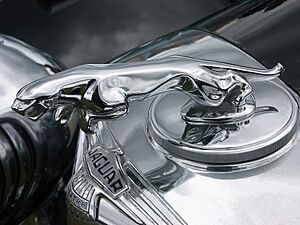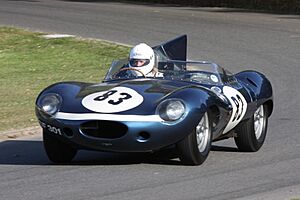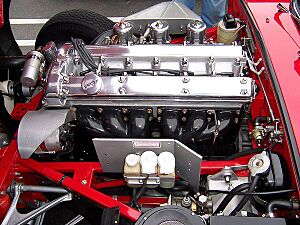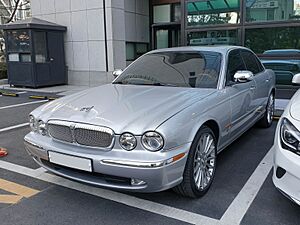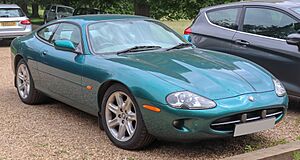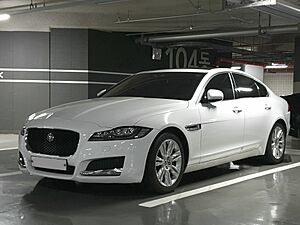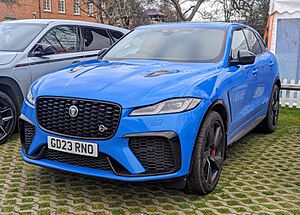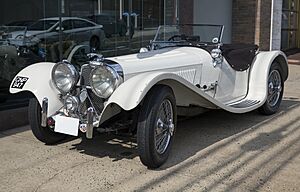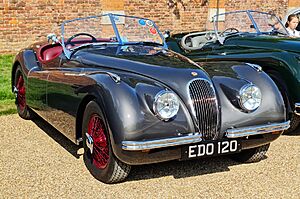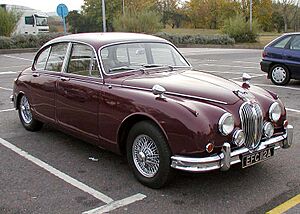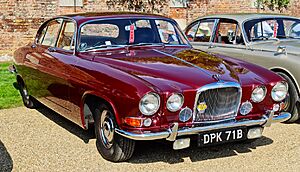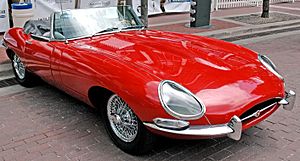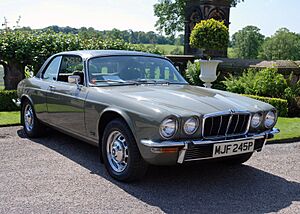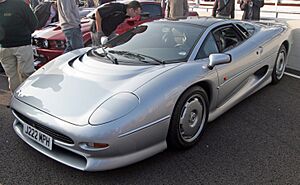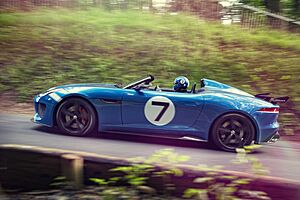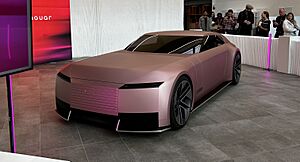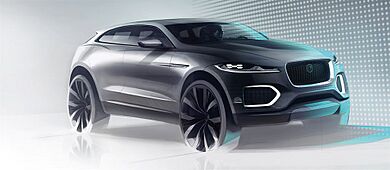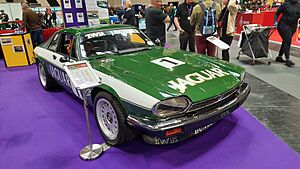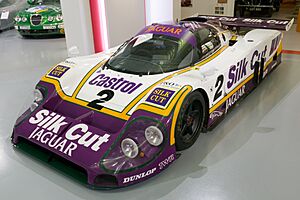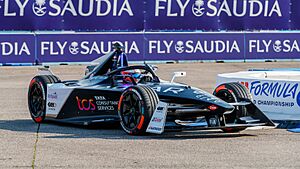Jaguar Cars facts for kids
| Owner | Jaguar Land Rover (since 2013) |
|---|---|
| Country | United Kingdom |
| Introduced | September 1935 |
| Related brands | Land Rover |
| Markets | Worldwide |
| Previous owners |
|
| Tagline | "Copy Nothing" |
 |
|
|
Formerly
|
SS Cars (1933–1945) |
|---|---|
| Industry | Automotive |
| Fate | Merged with Land Rover in 2013 |
| Predecessor | Swallow Sidecar Company |
| Successor | Jaguar Land Rover |
| Founded | 26 October 1933 |
| Founder | William Lyons |
| Defunct | 1 January 2013 |
| Headquarters |
,
England
|
| Parent |
|
Jaguar is a famous British brand known for its fast sports cars and fancy luxury vehicles. It is part of Jaguar Land Rover, a big car company based in Whitley, Coventry, England. The company that made Jaguar cars, called Jaguar Cars, joined with Land Rover on January 1, 2013, to form Jaguar Land Rover.
The business started in 1922 as the Swallow Sidecar Company. They first made sidecars for motorcycles. Later, they started building car bodies. The company was known as SS Cars from 1935 to 1945. During this time, some of their cars were called "Jaguar." In 1945, the company officially changed its name to Jaguar Cars.
Jaguar joined with British Motor Corporation in 1966, becoming British Motor Holdings. This group then merged with Leyland Motor Corporation in 1968, forming British Leyland. The British government took control of British Leyland in 1975.
Jaguar became a separate company again in 1984. It was then bought by Ford in 1990. Jaguar has made cars for the Prime Minister of the United Kingdom since the late 1970s. They also held special royal approvals from Queen Elizabeth II and King Charles III.
Ford owned Jaguar Cars and Land Rover until 2008. Then, they sold both brands to Tata Motors. Tata created Jaguar Land Rover as a new company. In 2013, Jaguar Cars and Land Rover officially merged. They became one company, Jaguar Land Rover, which designs, makes, and sells both Jaguar and Land Rover vehicles.
Since Ford owned them, Jaguar and Land Rover have shared design centers. These are in Whitley (Coventry) and Gaydon (Warwickshire). Jaguar cars have been built in factories at Castle Bromwich and Solihull. Jaguar Land Rover announced in February 2021 that all Jaguar brand cars would be fully electric by 2025.
Contents
The Story of Jaguar Cars
How Jaguar Started
The Swallow Sidecar Company began in 1922. It was started by two friends who loved motorcycles, William Lyons and William Walmsley. In 1934, Walmsley decided to leave the company. Lyons then created SS Cars to buy the business. He raised money by selling shares to the public.
The name "Jaguar" first appeared in September 1935. It was a model name for a sports car called the SS 2½-litre saloon. Another sports car, the SS Jaguar 100, had a 3½-litre engine.
On March 23, 1945, the company's owners agreed to change the name to Jaguar Cars Limited. William Lyons, the chairman, said the name "Jaguar" was unique. It could not be confused with any other foreign name.
After World War II, many people wanted new cars. But it was hard to make them because materials like steel were scarce. Jaguar sold a company that made car bodies, called Motor Panels. They also bought a factory from Standard Motor Company where Jaguar's engines were built. From then on, Jaguar relied on other companies to make their car bodies.
Jaguar became famous for making amazing sports cars. These included the Jaguar XK120 (1948–54), Jaguar XK140 (1954–57), Jaguar XK150 (1957–61), and Jaguar E-Type (1961–75). William Lyons believed in offering "value for money." These sports cars also did very well in international races. This helped show how well-engineered Jaguar's cars were.
Jaguar's sales motto for many years was "Grace, Space, Pace." This idea was perfectly shown by popular cars like the MK VII and the XJ6.
A key to Jaguar's success after the war was its twin-cam straight six engine. This engine was designed before the war. Engineers worked on it while also watching for fires at the Coventry factory. It was a powerful and advanced engine for its time.
This engine was used in many Jaguar cars, including the XK 120 and the E-Type. The E-Type was based on the successful C and D Type racing cars. The XK engine was so good that it was even used in military vehicles. A well-maintained XK engine could last for 200,000 miles.
Jaguar had proud moments in racing, winning the Le Mans 24 hours race in 1951 and 1953. They won again in 1956 and 1957 with the Ecurie Ecosse racing team.
William Lyons always wanted to build the company by making world-class luxury cars. These cars would be made in larger numbers than sports cars. Jaguar became financially stable and known for excellence. They made elegant luxury cars like the Mark VII and the XJ6. These cars were known for being good value, comfortable, easy to handle, and stylish.
Jaguar's reputation as a top car maker was strong. This was thanks to cars like the XK 120, XK 140, XK 150, and the amazing E-Type. Their achievements after the war were impressive, especially with material shortages.
Daimler Brand
In 1950, Jaguar leased a factory in Browns Lane, Coventry. This factory was used by Daimler. Jaguar moved its operations there over the next year. In 1960, Jaguar bought Daimler from BSA. From the late 1960s, Jaguar used the Daimler name for its most luxurious cars.
Joining Bigger Companies (1965–1984)
Pressed Steel Company Limited made all of Jaguar's car bodies. In 1965, British Motor Corporation (BMC) bought Pressed Steel. William Lyons worried about Jaguar's future. He decided to merge Jaguar with BMC to form British Motor (Holdings) Limited. This was announced on July 11, 1965.
Later, British Motor Holdings merged with Leyland Motor Corporation. This created British Leyland Motor Corporation in 1968. However, this big company did not do well. Poor decisions and financial problems led the British government to take control in 1975.
Becoming Independent Again (1984–1989)
It became clear that British Leyland could not invest enough in new car models, including Jaguars. So, in July 1984, Jaguar became a separate company again. Its shares were sold on the London Stock Exchange. This was part of the government's plan to sell off state-owned businesses.
Sir John Egan became chairman in 1980. He is credited with Jaguar's success after it became independent. By 1986, Egan had fixed major problems like quality control and slow deliveries. He also cut costs by reducing the number of employees. He focused on improving Jaguar's quality.
The Ford Years (1989–2008)
Ford bought Jaguar in November 1989. Jaguar's shares were removed from the London Stock Exchange in February 1990. In 1999, Jaguar became part of Ford's new Premier Automotive Group. This group also included Aston Martin, Volvo Cars, and later Land Rover. Jaguar did not make a profit under Ford's ownership.
Ford expanded Jaguar's car range. They launched the S-Type in 1999 and the X-type in 2001. After Ford bought Land Rover in 2000, Jaguar and Land Rover worked closely together. They shared sales networks and some car parts.
On June 11, 2007, Ford announced it planned to sell Jaguar and Land Rover. Many companies showed interest in buying them.
The Tata Motors Era (2008–Present)
On January 1, 2008, Ford announced that Tata Motors was the preferred buyer. Tata Motors received support from trade unions and Ford. On March 26, 2008, Ford agreed to sell Jaguar and Land Rover to Tata Motors of India. The deal was completed on June 2, 2008, for £1.7 billion. The deal also included rights to other British brands like Daimler, Lanchester, and Rover.
On January 18, 2008, Tata Motors created Jaguar Land Rover (JLR) as a new company. This company would own Jaguar Cars Limited and Land Rover. On January 1, 2013, Jaguar Cars Limited was renamed Jaguar Land Rover Limited. All Land Rover assets were transferred to it. This meant Jaguar Land Rover Limited became responsible for designing, making, and selling both Jaguar and Land Rover vehicles in the UK.
Jaguar's sales increased by 42% in 2013 compared to 2012. The biggest growth was in Germany and the United States. In 2020, Thierry Bolloré became the head of Jaguar Land Rover.
In 2023, JLR announced plans to make Jaguar a more exclusive brand. They wanted it to compete with luxury car makers like Bentley and Porsche. In June 2024, Jaguar stopped making all models except the F-Pace. This was part of their goal to become fully electric by 2025. Three new electric models are planned to be introduced starting in 2025.
Jaguar's Electric Future (2025–Present)
On November 19, 2024, Jaguar showed off its new logo and brand. This was before its relaunch in 2026 as an electric-only brand. The new look included a new font, colors, and a new symbol. The company called this direction "exuberant modernism."
This change caused some debate online. Critics said it might alienate Jaguar's traditional customers. Others praised it as "marketing genius" for getting worldwide attention.
On December 4, 2024, Jaguar revealed the Type 00 concept car at Miami Art Week. This car is not for sale but shows the design direction for future electric Jaguars. Like the rebrand, the car received mixed reactions.
Jaguar stopped making gasoline-powered cars in 2024. This led to a big drop in sales in 2025, as the company transitions to electric vehicles.
Jaguar Factories
The Swallow Sidecar company started in Blackpool in 1922. In 1928, they moved to Holbrook Lane, Coventry. This was because they needed more space for the popular Austin Swallow car. The company started using the "Jaguar" name while in Holbrooks Lane.
In 1951, Jaguar moved to the Browns Lane factory in Allesley, Coventry. This factory had been used by The Daimler Company during the war. Browns Lane stopped making cars in 2005. The XJ had already moved to Castle Bromwich two years before. The XK and S-Type followed. The Browns Lane factory has now been taken down and is being rebuilt.
Jaguar bought the Whitley engineering center from Peugeot in 1986. This site was once part of Chrysler Europe. In 2016, Jaguar also moved into part of the old Peugeot/Chrysler/Rootes site in Ryton-on-Dunsmore. This is now where Jaguar Land Rover restores classic cars.
Jaguar's Radford plant used to make Daimler buses. Later, it made Jaguar engines and axles. Ford closed it in 1997 and moved engine production to its Bridgend factory.
In 2000, Ford gave its Halewood factory to Jaguar. This was for Jaguar's new X-Type model. Later, the Land Rover Freelander 2 was also made there. Jaguar cars stopped being made at Halewood in 2009. Now, Halewood only makes Land Rover vehicles.
Since Jaguar Cars merged with Land Rover to form Jaguar Land Rover, they share many facilities. Most of these sites work on both Jaguar and Land Rover brands.
Current Car Models
Jaguar F-Pace
The F-Pace is a fancy crossover SUV. It was Jaguar's first SUV. It was shown at the International Motor Show Germany in September 2015. The F-Pace is expected to be made until early 2026, before Jaguar becomes fully electric.
Car Models No Longer Made (as of 2024)
Jaguar stopped making all gasoline-powered cars in 2024, except for the F-Pace.
Jaguar E-Pace
The Jaguar E-Pace is a smaller SUV. It was officially shown on July 13, 2017. Production of the E-Pace stopped in December 2024.
Jaguar F-Type
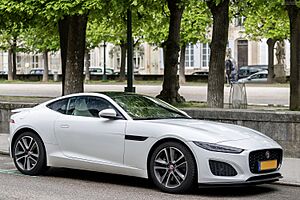
The F-Type convertible was launched at the 2012 Paris Motor Show. It was seen as a modern version of the famous E-Type. The F-Type is a two-seat sports car. It was inspired by Jaguar's C-X16 concept car from 2011. Sales started in 2013 with different engine choices. Production ended in June 2024, with 87,731 cars built.
Jaguar I-Pace
The Jaguar I-Pace is an electric SUV. It was officially shown on March 1, 2018. It was Jaguar's first electric car. Due to changing company plans, the I-Pace was discontinued by 2025. Production of the I-Pace ended in December 2024.
Jaguar XE
The XE was Jaguar's first compact luxury car since the X-Type. It was built using Jaguar's new aluminum design. This allowed it to have either rear-wheel drive or all-wheel drive. It was the first car in its class with an aluminum body. The XE was announced in 2014 and sales began in 2015. Production of the XE stopped in mid-2024.
Jaguar XF
The Jaguar XF is a mid-size luxury car. It was introduced in 2008 to replace the S-Type. The XF won "Car of the Year" awards in 2008. It was available with different gasoline and diesel engines. Production of the XF stopped in mid-2024.
Jaguar R and SVR Models
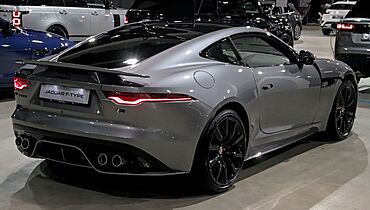
Jaguar started making "R" models in 1995 with the XJR. The first XKR came out in 1997. Jaguar R, R-S, and SVR models are high-performance versions. They compete with powerful cars from brands like Mercedes-AMG, BMW M, and Audi S and RS.
Famous Old Jaguar Cars
The company changed its name from SS Cars to Jaguar Cars in 1945. But from 1935 to 1945, the cars had "SS Jaguar" on them. During this time, they made the SS90 and the SS100. After 1945, the renamed Jaguar company continued to make pre-war models. These used engines designed by the Standard Motor Company. The larger engines were made by Jaguar itself. These cars are sometimes called "Mark IVs."
The first car after the war was the Mark V in September 1948. It looked a bit more modern. More importantly, it had new independent front suspension and hydraulic brakes.
A big moment was the launch of the XK120 sports car in October 1948. It had a new, powerful 3.5-liter engine. This engine was designed at night during the war. The XK120 was originally meant to be a limited production car. It was a test for the new engine before it went into the new Mark VII luxury car.
Another big success was the large Mark VII luxury car in 1950. This car was made especially for the American market. Jaguar received many orders for it. The Mark VII and its later versions received great reviews. In 1956, a Mark VII won the famous Monte Carlo Rally. The XK120 was followed by improved versions, the XK140 in 1954 and the XK150 in 1957.
In 1955, the "Two-point-four" saloon was Jaguar's first car with a single-piece body. It could go 100 miles per hour. In 1957, a 3.4-liter version was introduced, reaching 120 mph. In 1959, an updated version with larger windows became the Mark 2. The 3.8 Mark 2 was popular with British police because it was fast and small.
The Mark VIII (1956) and Mark IX (1958) were updates of the Mark VII. The large Mark X (1961) was a completely new luxury car. It had independent suspension all around. Jaguar launched the iconic E-Type in 1961.
The independent rear suspension from the Mark X was used in the 1963 S-Type. In 1967, the Mark 2 name was dropped. The 420 (1966) gave the S-type a new front look. The Mark X became the 420G in 1966. Jaguar was then helped by its new, more compact XJ6.
One of the most important luxury cars was the XJ (1968–1992). Over the years, the XJ had many updates. The most luxurious XJ models were called Vanden Plas (in the US) or Daimler (elsewhere). In 1972, a 12-cylinder engine was added to the XJ and E-Type. There was also a two-door XJ coupé called the XJ-C made from 1975 to 1977.
In 1992, Jaguar introduced the XJ220. This was a mid-engined, twin-turbo car with a 542 horsepower V6 engine. The XJ220 was confirmed as the fastest production car in the world at the time. It reached 217 mph on the Nardo track in Italy.
For many years, Jaguar cars had a chrome "Leaping Jaguar" mascot on the hood. This iconic mascot was later removed from cars sold in Europe for safety reasons. It is now no longer fitted on any new Jaguar models, though some owners add it themselves.
The Jaguar S-Type was made from 1999 to 2008. It was replaced by the Jaguar XF. Early S-Types had some reliability issues, but these were mostly fixed by 2004.
The Jaguar X-Type was a compact luxury car launched in 2001. It shared parts with the Ford Mondeo. X-Type production ended in 2009.
The Jaguar XK was a luxury sports car introduced in 2006. It replaced the XK8. The XK had an aluminum body and was available as a coupé or convertible. Production stopped in 2014.
The Jaguar XJ was a large luxury car. It was made from 1968 to 2019. The first XJ generation was the last car influenced by Jaguar's founder, Sir William Lyons.
In 2003, the third generation XJ (X350) arrived. Its outside looked traditional, but it was completely re-engineered inside. It had an advanced aluminum body.
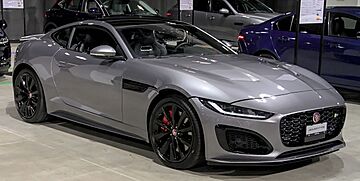
Jaguar responded to criticism with the fourth generation XJ, launched in 2009. Its design was more modern and youthful. The XJ Supersport, with its 5-liter V8 engine, could go from 0 to 60 mph in 4.7 seconds. For more space, all XJ models were offered with a longer wheelbase.
In 2024, Jaguar relaunched its brand with a new logo and concept car. The "Jaguar Type 00" was shown at the Miami Art Show. Its name "Type 00" is inspired by past Jaguar "Type" cars like the E-Type. The first "zero" means it's an electric car with zero emissions. The second "zero" means it's the start of a "whole new line of Jaguars." This concept car shows the direction for Jaguar's future electric car designs.
Jaguar's Global Sales (1988-2023)
- 1988 - 49,494
- 1992 - 20,000
- 1998 - 50,220
- 2008 - 65,000
- 2012 - 54,000
- 2013 - 77,000
- 2014 - 81,570
- 2015 - 83,986
- 2016 - 148,730
- 2017 - 178,601
- 2018 - 180,198
- 2019 - 161,601
- 2020 - 102,494
- 2021 - 86,270
- 2022 - 61,661
- 2023 - 64,241
Concept Cars
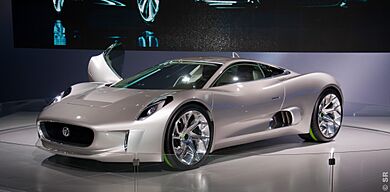
Concept cars are special cars made to show new ideas and designs. They are often not made for sale.
- E1A (1957) – An early E-Type idea.
- E2A (1960) – A second E-Type concept that raced.
- XJ13 (1966) – Built for racing, but never competed.
- Pirana (1967) – Designed by Bertone.
- Ascot (1977)
- XJ41/XJ42 (1982-1990) – An early F-Type idea that was cancelled.
- XJ90 (1988-1991) – A planned replacement for the XJ40, also cancelled.
- Kensington (1990)
- XK 180 (1998) – A sports car concept based on the XK8.
- F-Type (2000) – A smaller sports car concept.
- R-Coupé (2001) – A large four-seat coupé.
- Fuore XF 10 (2003)
- R-D6 (2003) – A compact four-seat coupé.
- XKR-R (2001) – A high-performance version of the first XK coupé.
- XK-RS (2004) – Another performance version of the first XK convertible.
- Concept Eight (2004) – A super-luxury version of the XJ.
- Advanced Lightweight Coupe Concept (2005) – Showed what the second generation Jaguar XK would look like.
- C-XF (2007) – A preview of the XF luxury car.
- C-X75 (2010) – A hybrid-electric sports car, planned for production but cancelled.
- B99 (2011)
- C-X16 (2011) – A preview of the F-Type.
- C-X17 (2013) – Jaguar's first SUV concept.
- Project 7 (2013) – A powerful sports car based on the F-Type, inspired by the D-Type.
- Future-Type (2017)
- Jaguar Vision Gran Turismo SV (2020) – A concept car for the Gran Turismo video game.
- Jaguar Type 00 (2024) – A concept car showing the future design of Jaguar's electric cars.
Jaguar Engines
Jaguar has designed six generations of engines:
- Older Engines:
- XK6 – A straight-six engine.
- V12 – A V12 engine.
- AJ6/AJ16 – A straight-six engine.
- AJ-V6 – A V6 engine (modified by Jaguar from a Ford design).
- Newer Engines:
- AJ-V8 – A V8 engine.
- AJ126 – A V6 engine.
- AJD-V6 – A V6 diesel engine (designed by Ford).
- Ingenium – An inline-4 engine.
Jaguar in Motorsport
Jaguar has been very successful in sports car racing, especially at the Le Mans 24 Hours race. They won with the C-Type in 1951 and 1953. Then, they won in 1955, 1956, and 1957 with the D-Type. The racing team manager, Lofty England, later became Jaguar's CEO.
In 1982, Jaguar started working with Tom Walkinshaw Racing. Their XJ-S car won the European Touring Car Championship in 1984. In the mid-1980s, they started making powerful Group C cars for the World Sports Prototype Championship. The team won regularly from 1987. They won Le Mans in 1988 and 1990 with the XJR series cars. The Jaguar XJR-14 won the 1991 World Sportscar Championship.
In 1999, Ford decided that Jaguar would be its Formula One team. Ford bought the Stewart Grand Prix team and renamed it Jaguar Racing for the 2000 season. However, the Jaguar F1 program was not very successful. It only achieved two podium finishes in five seasons (2000-2004). At the end of 2004, Ford sold the F1 team to Red Bull, which renamed it Red Bull Racing.
On December 15, 2015, Jaguar announced it would return to motorsport in Formula E. This is a racing series for electric cars.
On June 15, 2018, Jaguar Vector Racing broke the world speed record for an electric boat. The Jaguar Vector V20E went an average of 88.61 mph.
Jaguar plans to stay in Formula E until 2030. As of July 2024, Jaguar has won 16 races in Formula E. They have also won one Teams' Championship and one Manufacturers' Trophy. Their electric powertrain also helped another team, Envision, win the teams' title in the 2022-23 season.
Some famous Jaguar race cars include:
- Jaguar C-Type (1951–1953)
- Jaguar D-Type (1954–1957)
- Jaguar Lightweight E-Type
- Jaguar XJ13
- Jaguar XJR Sportscars
- Jaguar XJR-9 (1988)
- XJ220 (1988)
- XJR-15 (1990)
Images for kids


